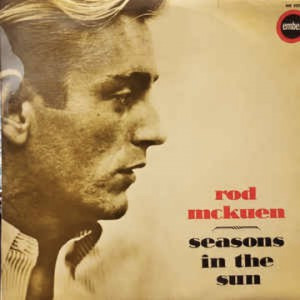Music has a unique ability to evoke powerful emotions, and few songs tap into the raw nerve of human sentimentality quite like “Seasons in the Sun.” For many, particularly those who grew up in the 1970s, the Terry Jacks rendition of this song is inextricably linked to childhood memories, perhaps even a first encounter with the concept of mortality. It’s a song that, despite its saccharine reputation, has sold millions of copies worldwide and continues to resonate decades later. But what is it about this seemingly simple tune that has captured the hearts of so many, while earlier versions of the same song failed to achieve similar success?
To understand the enduring appeal of the “Seasons Of The Sun Song”, we need to delve into its history, explore its lyrical transformations, and ultimately uncover why Terry Jacks’ stripped-down, emotionally direct version became the definitive and massively popular hit. This isn’t just a story about a song; it’s an exploration of how cultural shifts and emotional honesty can elevate a simple melody to iconic status.
The Origins of “Seasons of the Sun”: From French Ballad to Pop Hit
The journey of “Seasons in the Sun” begins not in the sunny shores of North America, but in the somber world of French chanson. The original song, “Le Moribond,” was written and performed by the renowned Belgian singer-songwriter Jacques Brel. Released in 1961, Brel’s version presents a cynical and detached farewell from a dying man. In “Le Moribond,” the narrator bids adieu to his best friend, a priest, his wife’s lover, and finally, his unfaithful wife. The tone is far from sentimental; it’s laced with irony and a worldly acceptance of life’s betrayals and inevitable end. The chorus, far from being tearful, is a request for laughter and revelry at his funeral, emphasizing a cynical detachment from death.
Rod McKuen, an American poet and singer, encountered “Le Moribond” and in 1963 penned an English adaptation titled “Seasons in the Sun.” McKuen claimed to have aimed for a close translation but acknowledged softening some of the French original’s “rougher” edges for American sensibilities. However, McKuen’s version takes significant liberties. While retaining the melody and the dying man’s farewell concept, McKuen crafts a new narrative. He eliminates the wife’s lover, combining the friend and betrayer into one character, Emile, and replaces the priest with a father figure. Crucially, McKuen introduces the element of betrayal, making the wife’s infidelity a central theme and adding a bitter, haunting edge to the farewell.
 Rod McKuen Seasons in the Sun album cover
Rod McKuen Seasons in the Sun album cover
Rod McKuen’s “Seasons in the Sun” album cover, showcasing his interpretation of the Jacques Brel classic and hinting at the poetic and sentimental style he brought to the song.
Despite these changes, McKuen’s “Seasons in the Sun” still retained a layer of worldly cynicism, particularly in the verse directed at the unfaithful wife. Before Terry Jacks, other artists attempted to popularize McKuen’s version. The Kingston Trio, known for their folk harmonies, released a version in 1964, and British pop group The Fortunes followed suit in 1969. Both renditions largely mirrored McKuen’s arrangement and lyrical content, including the verse about infidelity. However, none of these versions achieved significant commercial success. The melody was undeniably catchy, and the theme of farewell held emotional weight, yet something was missing to propel “seasons of the sun song” into the stratosphere of pop hits.
 Excerpts from Rod McKuen album liner notes with quotes and back cover image
Excerpts from Rod McKuen album liner notes with quotes and back cover image
Liner notes from Rod McKuen’s album featuring testimonials, indicating the marketing approach to position McKuen as a respected artist beyond just his music, aiming for broader appeal.
 Rod McKuen album back cover with testimonials and tracklist
Rod McKuen album back cover with testimonials and tracklist
The back cover of Rod McKuen’s album, highlighting critical acclaim and further emphasizing the attempt to establish McKuen’s artistic credibility and attract a wider audience.
Terry Jacks’ Transformation: Stripping Away Cynicism for Emotional Impact
Enter Terry Jacks. A Canadian musician who had previously found success with his band The Poppy Family, Jacks recognized the inherent potential in “Seasons in the Sun,” specifically the Kingston Trio’s version. He even attempted to have The Beach Boys record it, but they ultimately deemed it “too cheesy.” However, Jacks’ own solo rendition, released in 1974, would become a global phenomenon.
Jacks’ genius lay not in adding complexity, but in radical simplification. He audaciously stripped away the cynicism and worldly knowingness that permeated both Brel and McKuen’s versions. The most crucial change was the complete removal of the third verse – the one detailing the wife’s infidelity. In its place, Jacks substituted lyrics of pure, unadulterated sentimentality: “You gave me love and helped me find the sun / And every time that I was down you’d always come around and get my feet back on the ground.”
This lyrical alteration was transformative. The focus shifted entirely from betrayal and bitter irony to simple, heartfelt remorse at leaving loved ones behind. Michelle, Francoise in McKuen’s version, becomes a symbol of pure, unwavering support and love. The dying man in Jacks’ rendition is not grappling with complex emotions or hidden truths; he is simply overwhelmed by the sadness of departure and the appreciation for the good times shared. The “joy and fun” and “seasons in the sun” chorus, already present in McKuen, becomes the emotional core of Jacks’ interpretation, amplified by the surrounding verses of uncomplicated farewells to a friend, father, and lover.
The Power of Naivety: Why Jacks’ Version Succeeded
The critical response to Terry Jacks’ “Seasons in the Sun” was often dismissive, labeling it as saccharine and emotionally manipulative. Yet, its immense commercial success cannot be denied. Why did a seemingly “less sophisticated” version resonate so powerfully with the masses? The answer lies in its emotional directness and its willingness to confront a universal fear without intellectual barriers.
Brel’s cynicism and McKuen’s worldly bitterness, while perhaps artistically interesting, created a distance between the song and the listener. They offered a degree of emotional armor, a way to contemplate death through a lens of irony or betrayal. Terry Jacks, in his naivety (or perhaps, intuitive understanding of popular sentiment), tore down those defenses. He presented death not as a moment for cynical reflection, but as a purely sad and terrifying prospect – the ultimate farewell to joy, love, and simple pleasures.
In a way, Terry Jacks’ “Seasons in the Sun song” functions similarly to Edvard Munch’s iconic painting, “The Scream.” Both works, in their own mediums, tap into a primal, unspoken dread that underlies human existence.
 Edvard Munch's The Scream painting
Edvard Munch's The Scream painting
Edvard Munch’s “The Scream,” a visual representation of existential dread, mirroring the raw emotionality that Terry Jacks captured in his version of “Seasons in the Sun.”
“The Scream” is not subtle or nuanced; it is a raw, unfiltered expression of anguish. Similarly, Jacks’ “Seasons in the Sun” eschews subtlety for emotional transparency. It doesn’t offer clever insights or sophisticated perspectives on death; it simply allows listeners to wallow in the sadness of it all, to confront the terror of non-existence in a safe, melodic space. The very “cheesiness” that critics derided became a strength, making the song accessible and emotionally potent for a vast audience.
 Satirical refrigerator magnets of The Scream
Satirical refrigerator magnets of The Scream
Satirical refrigerator magnets featuring “The Scream,” illustrating how even profound expressions of dread can become diluted or trivialized through popular culture, much like the initial critical reaction to the emotional directness of “Seasons in the Sun.”
“Seasons in the Sun Song” in Pop Culture: Legacy and Impact
“Seasons in the Sun song” became an international phenomenon, cementing Terry Jacks’ place in pop music history, albeit as something of a one-hit-wonder. While the song may be perceived by some as a guilty pleasure or even a joke, its enduring popularity speaks to its profound emotional impact. It remains a staple on oldies radio, continues to be covered by artists across genres, and evokes strong feelings of nostalgia and sentimentality for generations of listeners.
The legacy of “Seasons in the Sun” is a testament to the power of emotional honesty in music. By stripping away cynicism and embracing raw, uncomplicated sentiment, Terry Jacks unlocked a universal chord, tapping into the fundamental human fear of loss and the preciousness of life’s fleeting moments. It’s a reminder that sometimes, the most profound artistic statements are not the most complex or intellectually challenging, but those that dare to speak directly to the heart, even if it means embracing a little bit of “cheese” along the way.
